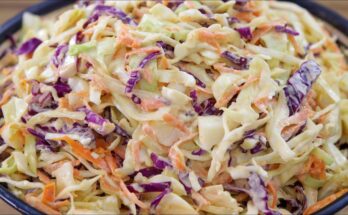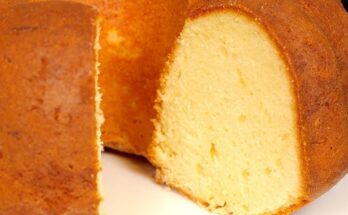Loaded Potato Soup Recipe: There’s nothing quite as comforting as a warm bowl of loaded potato soup on a chilly day. This rich, creamy, and flavorful dish brings together the best ingredients—potatoes, cheese, bacon, and creamy broth—to create the ultimate comfort food. Whether you’re making it for a cozy dinner at home or serving it at a gathering, this soup is guaranteed to be a crowd-pleaser.
One of the best things about loaded potato soup is how versatile it is. You can customize the ingredients to match your personal preferences, making it as indulgent or as healthy as you like. In this guide, we’ll walk you through each step to ensure you get the perfect consistency, flavor, and toppings.
So, grab your ingredients, and let’s get cooking!
Ingredients Needed
Before we start, let’s gather everything you’ll need:
Main Ingredients:
- 4 large russet potatoes, peeled and diced
- 6 slices of bacon, cooked and crumbled
- 1 medium onion, finely chopped
- 2 cloves garlic, minced
- 4 cups chicken broth (or vegetable broth for a vegetarian version)
- 2 cups whole milk (or heavy cream for extra richness)
- 1 cup shredded cheddar cheese
- ½ cup sour cream
- 3 tablespoons butter
- 3 tablespoons all-purpose flour
- Salt and pepper to taste
Optional Add-ins for Extra Flavor:
- ½ teaspoon smoked paprika (for a smoky depth)
- 1 teaspoon dried thyme
- 1 cup cooked ham or sausage (for extra protein)
- ½ teaspoon cayenne pepper (if you like a little heat)
Step-by-Step Instructions
Now that we have everything ready, let’s break it down step by step.
Step 1: Preparing the Potatoes
Start by peeling and dicing your potatoes into small cubes. The smaller the cubes, the faster they will cook. Place the diced potatoes in a bowl of cold water while you prep the other ingredients—this helps remove excess starch and prevents browning.
Step 2: Cooking the Bacon
Heat a large pot or Dutch oven over medium heat. Add the bacon slices and cook until crispy, about 5-7 minutes. Remove the bacon and place it on a paper towel-lined plate to drain. Once cooled, crumble into small pieces and set aside.
Step 3: Making the Roux
In the same pot (with the bacon grease), add butter and chopped onions. Cook for 2-3 minutes until onions turn translucent. Stir in minced garlic and cook for another 30 seconds. Sprinkle flour over the mixture and whisk continuously for 1-2 minutes until it turns light golden brown. This creates the base for a thick and creamy soup.
Step 4: Adding the Broth and Potatoes
Slowly pour in the chicken broth, stirring constantly to prevent lumps. Add the drained potatoes and bring everything to a boil. Reduce the heat and let it simmer for about 15-20 minutes or until the potatoes are fork-tender.
Step 5: Blending for Creamy Texture
Once the potatoes are soft, you have two options:
- Use a potato masher to mash some of the potatoes while keeping some chunks for texture.
- For an ultra-creamy soup, use an immersion blender to puree most of the soup.
Step 6: Adding Cheese and Dairy
Lower the heat and stir in milk, shredded cheddar cheese, sour cream, salt, and pepper. Continue stirring until everything is well combined and the cheese is melted. Avoid boiling at this stage to prevent curdling.
Seasoning and Flavor Enhancements
To take your soup to the next level, consider these extra seasonings:
- Smoked paprika adds a subtle smoky flavor.
- A dash of Worcestershire sauce enhances umami.
- A pinch of cayenne pepper gives a slight kick.
Serving Suggestions
Best Toppings for Loaded Potato Soup
- Extra shredded cheddar cheese
- Crispy bacon bits
- Chopped green onions
- Sour cream or Greek yogurt
- Croutons for crunch
What to Serve with It
- Garlic bread or breadsticks
- A fresh green salad
- Grilled cheese sandwiches
Storage and Reheating Tips
- Storage: Keep leftovers in an airtight container in the fridge for up to 4 days.
- Reheating: Warm on the stove over low heat, adding a little milk or broth to adjust consistency.
- Freezing: Avoid freezing due to the dairy content—it can separate when thawed.
Healthier Alternatives
Want a lighter version? Try these swaps:
- Use cauliflower instead of potatoes for fewer carbs.
- Substitute Greek yogurt for sour cream.
- Use turkey bacon for a leaner option.
FAQs about Loaded Potato Soup Recipe
What type of potatoes is best for loaded potato soup?
For the creamiest texture, use starchy potatoes like Russets or Yukon Golds. They break down well during cooking, thickening the soup naturally.
Can I make loaded potato soup in a slow cooker?
Absolutely! Combine all ingredients except for the cream and toppings in the slow cooker. Cook on low for 5-6 hours or high for 3-4 hours. Stir in the cream just before serving and garnish with your favorite toppings.
Is loaded potato soup gluten-free?
Yes, this soup can easily be made gluten-free. Just ensure that all your ingredients, such as broth and bacon, are certified gluten-free.
How can I thicken my potato soup?
If your soup is too thin, mash some of the potatoes directly in the pot or use a blender to puree a portion of the soup and then mix it back in. You can also add a slurry of cornstarch and water to achieve your desired consistency.
What toppings go well with loaded potato soup?
Traditional toppings include shredded cheddar cheese, crisp bacon bits, chopped green onions, and a dollop of sour cream. Feel free to get creative with other toppings like roasted corn, diced ham, or crispy fried onions.
Can I freeze loaded potato soup?
While you can freeze potato soup, it’s worth noting that the texture may change due to the dairy components separating when thawed. It’s best enjoyed fresh, but if you need to freeze it, leave out the cream and add it when reheating.
What’s the best way to reheat leftover potato soup?
Reheat gently on the stove over medium heat, stirring frequently to prevent sticking. If the soup has thickened in the fridge, you may need to add a little milk or broth to thin it to your preferred consistency.
For more tips and tricks on making the perfect loaded potato soup, visit our detailed recipe page!
Enjoy your delicious Loaded Potato Soup! Don’t forget to try different toppings and make it your own.



